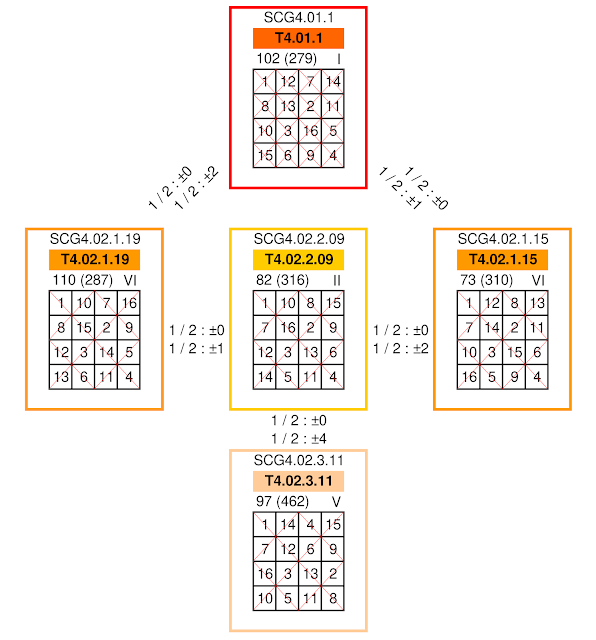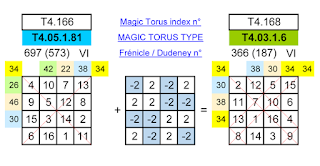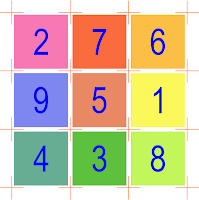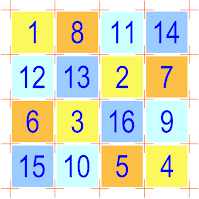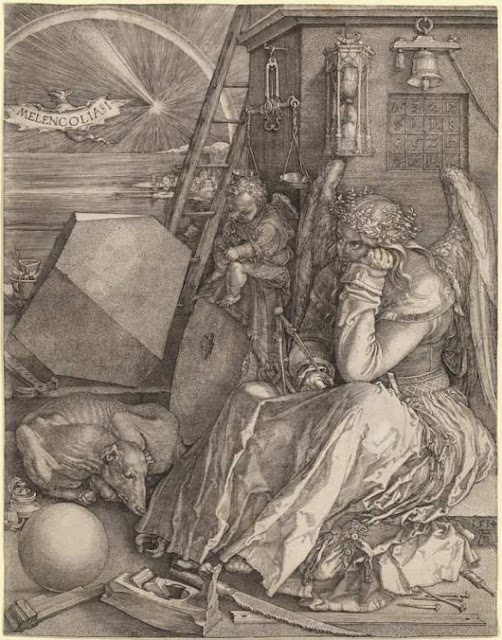
A magic torus can be found with any magic square, as has already been demonstrated in the article "From the Magic Square to the Magic Torus". In fact, there are n^2 essentially different semi-magic or magic squares, displayed by every magic torus of order-n. Particularly interesting to observe with pandiagonal (or panmagic) examples, a magic torus can easily be represented by repeating the number cells of one of its magic square viewpoints outside its limits. However, once we begin to look at area magic squares, it becomes much less evident to visualise and construct the corresponding area magic tori using repeatable area cells, especially when the latter have to be irregular quadrilaterals... The following illustration shows a sketch of an area magic torus of order-3 that I created back in January 2017. I call it a sketch because it may be necessary to use consecutive areas starting from 2 or from 3, should the construction of an area magic torus of order-3, using consecutive areas from 1 to 9, prove to be impossible. And while it can be seen that such a torus is theoretically constructible, many calculations will be necessary to ensure that the areas are accurate, and that the irregular quadrilateral cells can be assembled with precision:

At the time discouraged by the complications of such geometries, I decided to suspend the research of area magic tori. But since the invention of area magic squares, other authors have introduced some very interesting polyomino versions that open new perspectives:
Intention and Definition
The intention of the present article is to explore the use of
polyominoes for area magic torus construction, with the objective of facilitating the calculation
and verification of the cell areas, while avoiding the geometric constraints of irregular quadrilateral assemblies. Here, it is useful to give a definition of a polyomino area magic torus:
1/ In the diagram of the torus, the entries of the cells of each column, row, and of at least two intersecting diagonals, will add up to the same magic sum. The intersecting magic diagonals can be offset or
broken, as the area magic torus has a limitless surface, and can therefore display
semi-magic square viewpoints.
2/ Each cell will have an area in proportion to its number. The different areas will be represented by tiling with same-shaped holeless polyominoes.
3/ The cells can be of any regular or irregular rectangular shape that results from their holeless tiling.
5/ The vertex meeting points of four cells can only take place at four convex (i.e. 270° exterior angled) vertices of each of the cells.
Polyomino Area Magic Tori (PAMT) of Order-3
 |
Polyomino Area Magic Torus (PAMT) of order-3. Magic sums = 15. Tetrominoes.
Consecutively numbered areas 1 to 9, in an irregular rectangular shape of 180 units. |
 |
Polyomino Area Magic Torus (PAMT) of Order-3. Magic sums = 18. Trominoes.
Consecutively numbered areas 2 to 10, in an irregular rectangular shape of 162 units. |
 |
Polyomino Area Magic Torus (PAMT) of order-3. Magic sums = 24. Trominoes.
Consecutively numbered areas 4 to 12, in an oblong 12 ⋅ 18 = 216 units. |
 |
Polyomino Area Magic Torus (PAMT) of Order-3. Magic sums = 36. Trominoes Version 1.
Square 18 ⋅ 18 = 324 units. |
 |
Polyomino Area Magic Torus (PAMT) of Order-3. Magic sums = 36. Trominoes Version 2.
Square 18 ⋅ 18 = 324 units. |
 |
Polyomino Area Magic Torus (PAMT) of Order-3. Magic sums = 60. Pentominoes Version 1.
Square 30 ⋅ 30 = 900 units. |
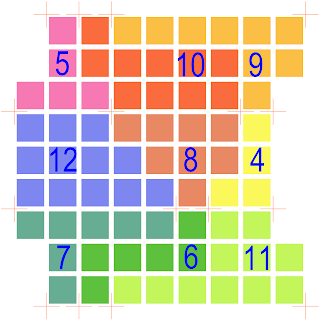 |
Polyomino Area Magic Torus (PAMT) of order-3. Magic sums = 24. Monominoes.
Consecutively numbered areas 4 to 12, in an irregular rectangular shape of 72 units. |
 |
Polyomino Area Magic Torus (PAMT) of order-3. Magic sums = 27. Monominoes Version 1.
Consecutively numbered areas 5 to 13, in a square 9 ⋅ 9 = 81 units. |
 |
Polyomino Area Magic Torus (PAMT) of order-3. Magic sums = 27. Monominoes Version 2.
Consecutively numbered areas 5 to 13, in a square 9 ⋅ 9 = 81 units. |
Polyomino Area Magic Tori (PAMT) of Order-4
The pandiagonal torus above displays 16 Frénicle indexed magic squares n° 107, 109, 171, 204, 292, 294, 355, 396, 469, 532, 560, 621, 691, 744, 788, and 839. It is entirely covered by 16 sub-magic 2x2 squares. The torus is self-complementary and has the magic torus complementary number pattern I. The even-odd number pattern is P4.1. This torus is extra-magic with 16 extra-magic nodal intersections of 4 magic lines.
It displays pandiagonal Dudeney I Nasik magic squares. It is classified with a Magic Torus index n° T4.198,
and is of Magic Torus type n° T4.01.2. Also, when compared with its two pandiagonal torus cousins of order-4, the unique Magic Torus T4.198 of the Multiplicative Magic Torus MMT4.01.1 is distinguished by its total self-complementarity.
 |
Pandiagonal Polyomino Area Magic Torus (PAMT) of order-4. Magic sums = 34. Pentominoes.
Index PAMT4.198, Version 1, Viewpoint 1/16, displaying Frénicle magic square index n° 107.
Consecutively numbered areas 1 to 16, in an oblong 34 ⋅ 20 = 680 units. |
 |
Pandiagonal Polyomino Area Magic Torus (PAMT) of order-4. Magic sums = 50. Dominoes.
Version 1, Viewpoint 1/16.
Consecutively numbered areas 5 to 20, in a square 20 ⋅ 20 = 400 units. |
 |
Pandiagonal Polyomino Area Magic Torus (PAMT) of Order-4. Sums = 50. Dominoes.
Version 1, Viewpoint 16/16.
Consecutively numbered areas 5 to 20, in an irregular rectangular shape of 400 units. |
Polyomino Area Magic Tori (PAMT) of Order-5
 |
Pandiagonal Torus type n° T5.01.00X of order-5. Magic sums = 65.
Please note that this is not a Polyomino Area Magic Torus. |
This pandiagonal torus of order-5 displays 25 pandiagonal magic squares.
It is a direct descendant of the T3 magic torus of order-3, as demonstrated in page 49 of "Magic Torus Coordinate and Vector Symmetries" (MTCVS).
In "Extra-Magic Tori and Knight Move Magic Diagonals" it is shown to be an Extra-Magic Pandiagonal Torus Type T5.01 with 6 Knight Move Magic Diagonals. Note that when centred on the number 13, the magic square viewpoint becomes associative. The torus is classed under type n° T5.01.00X (provisional number), and is one of 144 pandiagonal or panmagic tori type 1 of order-5 that display 3,600 pandiagonal or panmagic squares. On page 72 of "Multiplicative Magic Tori" it is present within the type MMT5.01.00x.
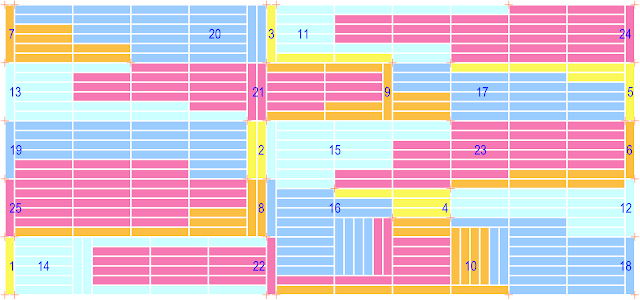 |
Pandiagonal Polyomino Area Magic Torus (PAMT) of order-5. Magic sums = 65. Hexominoes.
Index PAMT5.01.00X, Version 1, Viewpoint 1/25.
Consecutively numbered areas 1 to 25, in an oblong 65 ⋅ 30 = 1950 units. |
 |
Pandiagonal Polyomino Area Magic Torus (PAMT) of Order-5. Magic sums = 125. Monominoes.
Version 1, Viewpoint 1/25.
Consecutively numbered areas 13 to 37, in a square 25 ⋅ 25 = 625 units. |
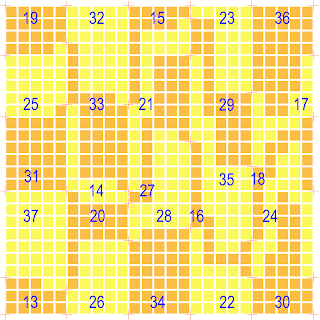 |
Pandiagonal Polyomino Area Magic Torus (PAMT) of Order-5. Magic sums = 125. Monominoes.
Version 2, Viewpoint 1/25.
Consecutively numbered areas 13 to 37, in a square 25 ⋅ 25 = 625 units. |
Polyomino Area Magic Tori (PAMT) of Order-6
 |
Partially Pandiagonal Torus type n° T6 of order-6. Magic sums = 111.
Please note that this is not a Polyomino Area Magic Torus. |
Harry White has kindly authorised me to use this order-6 magic square viewpoint. With a supplementary broken magic diagonal (24, 19, 31, 3, 5, 29), this partially pandiagonal torus displays 4 partially pandiagonal squares and 32 semi-magic squares. In "Extra-Magic Tori and Knight Move Magic Diagonals" it is shown to be an Extra-Magic Partially Pandiagonal Torus of Order-6 with 6 Knight Move Magic Diagonals. This is one of 2627518340149999905600 magic and semi-magic tori of order-6 (total deduced from findings by Artem Ripatti - see OEIS A271104 "Number of magic and semi-magic tori of order n composed of the numbers from 1 to n^2").
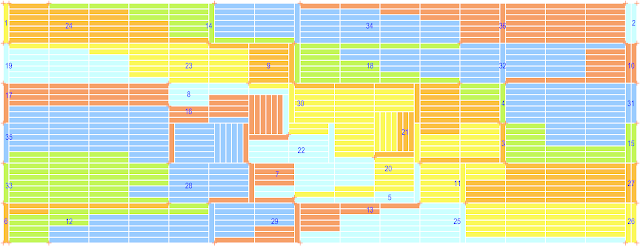 |
Partially Pandiagonal Polyomino Area Magic Torus (PAMT) of order-6. Magic sums = 111.
Heptominoes, Version 1, Viewpoint 1/36.
Consecutively numbered areas 1 to 36, in an oblong 111 ⋅ 42 = 4662 units. |
 |
Partially Pandiagonal Polyomino Area Magic Torus (PAMT) of order-6. Sums = 147.
Dominoes, Version 1, Viewpoint 1/36.
Consecutively numbered areas 7 to 42, in a square 42 ⋅ 42 = 1764 units. |
Observations
As they are the first of their kind, these Polyomino Area Magic Tori (PAMT) can most likely be improved: The examples illustrated above are all constructed with their cells aligned horizontally or vertically; and though it is convenient to do so, because it allows their representation as oblongs or squares, this method of constructing PAMT is not obligatory. Representations of PAMT that have irregular rectangular contours may well give better results, with less-elongated cells and simpler cell connections.
While the use of polyominoes has the immense advantage of allowing the construction of area magic tori with easily quantifiable units, it also introduces the constraint of the tiling of the cells. It has been seen in the examples above that the PAMT can be represented as oblongs or as squares, while other irregular rectangular solutions also exist. A normal magic square of order-3 displays the numbers 1 to 9 and has a total of 45, which is not a perfect square. As the smallest addition to each of the nine numbers 1 to 9, in order to reach a perfect square total is four (45 + 9 ⋅ 4 = 81), this implies that when searching for a square PAMT with consecutive areas of 1 to 9, in theory the smallest polyominoes for this purpose will be pentominoes.
But to date, in the various shaped examples of PAMT shown above, the smallest cell area used to represent the area 1 is a tetromino, as this gives sufficient flexibility for the connections of a nine-cell PAMT of order-3 with consecutive areas of 1 to 9. Edo Timmermans has already constructed a Polyomino Area Magic Square of order-3 using pentominoes for the consecutive areas of 1 to 9, but it seems that such polyominoes cannot be used for the construction of a same-sized and shaped PAMT of order-3. Straight polyominoes are always used in the examples given above, as these facilitate long connections, but other polyomino shapes will in some cases be possible.
We should keep in mind that the PAMT are theoretical, in that, per se, they cannot tile a torus: As a consequence of Carl Friedrich Gauss's "Theorema Egregium", and because the Gaussian curvature of the torus is not always zero, there is no local isometry between the torus and a flat surface: We can't flatten a torus without distortion, which therefore makes a perfect map of that torus impossible. Although we can create conformal maps that preserve angles, these do not
necessarily preserve lengths, and are not ideal for our purpose. And while two topological spheres are conformally equivalent, different
topologies of tori can make these conformally distinct and lead to further mapping complications. For those wishing to know more, the paper by Professor John M. Sullivan, entitled "Conformal Tiling on a Torus", makes excellent reading.
Notwithstanding their theoreticality, the PAMT nevertheless offer an interesting field of research that transcends the complications of tiling doubly-curved torus surfaces, while suggesting interesting patterns for planar tiling: For
those who are not convinced by 9-colour tiling, 2-colour pandiagonal tiling
can also be a good choice for geeky living spaces:
 |
| Tiling with irregular rectangular shaped PAMT of order-3. Monominoes. S=24. |
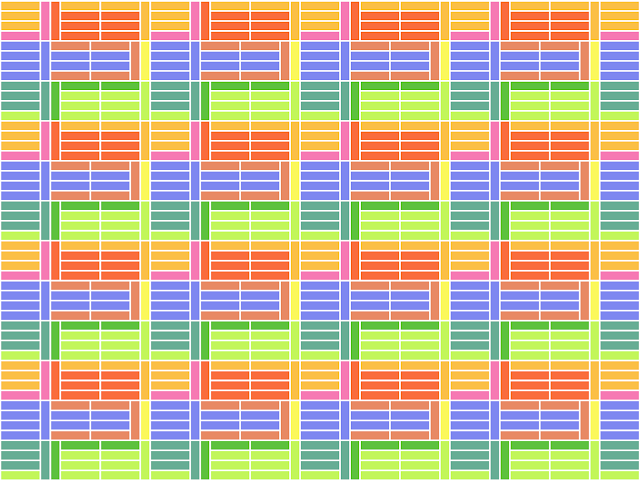 |
| Tiling with irregular rectangular shaped PAMT of order-3. Tetrominoes. S=15. |
 |
| Tiling with irregular rectangular shaped PAMT of order-3. Trominoes. S=18. |
 |
| Tiling with oblong PAMT of order-3. Trominoes. S=24. |
 |
| Tiling with oblong pandiagonal PAMT of order-4. Pentominoes. S=34. |
 |
| Tiling with oblong pandiagonal PAMT of order-5. Hexominoes. S=65. |
 |
| Tiling with square pandiagonal PAMT of order-5. Monominoes. S=125. |
 |
| Tiling with oblong partially pandiagonal PAMT of order-6. Heptominoes. S=111. |
 |
| Tiling with square partially pandiagonal PAMT of order-6. Dominoes. S=147. |
There are still plenty of other interesting PAMT that remain to be found, and I hope you will authorise me to publish or relay your future discoveries and suggestions!
